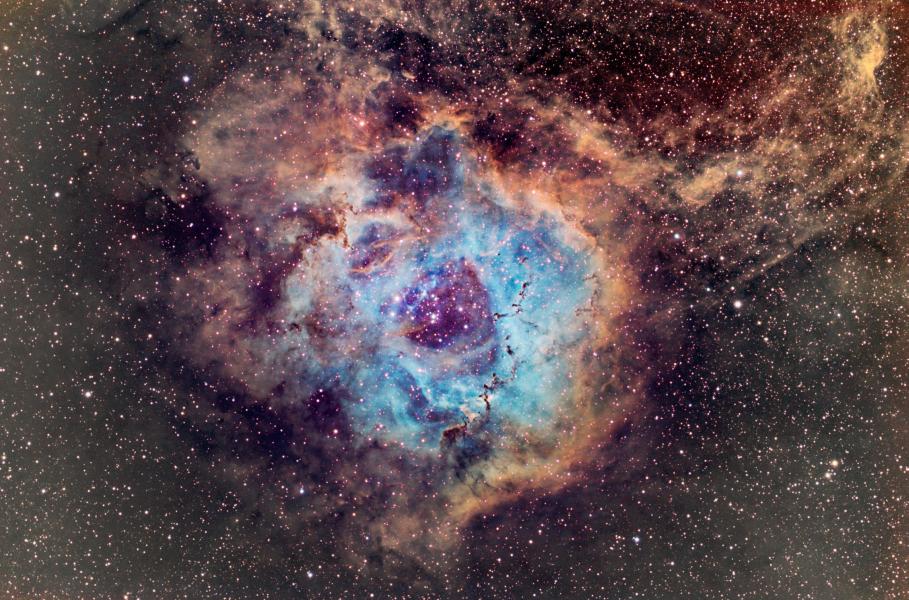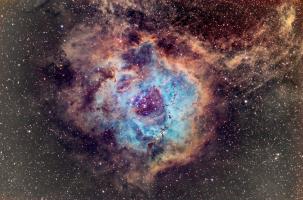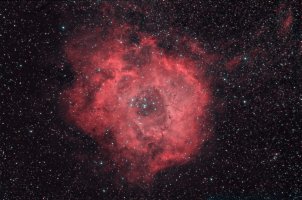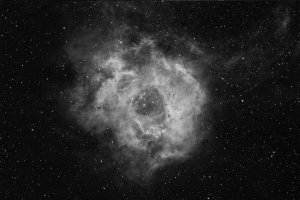The Rosette Nebula |
|||
 |
|||
|
|||
| I was not aware of the Rosette Nebula until relatively "late" in my adulthood, when I went from "armchair"
to "field" astronomy. A picture of the Rosette Nebula in the first edition of "The Backyard Astronomer's Guide", taken with
Kodak Tech Pan film through a hydrogen-alpha filter, grabbed hold of me and was one of the objects that I resolved to shoot if I ever got into astrophotography. The Rosette Nebula blooms in the fall constellation Monoceros. Where is Monoceros? Why, it's just east of Orion. So if you see Orion high in the fall (for the northern hemisphere anyway) sky, the region of sky to its east (rising "behind" it) is Monoceros. Emission nebulae (so-called because they glow, or "emit light", from radiation of stars embedded within them) are usually star-forming regions. Open cluster NGC 2244 is associated with and resides within this nebula. In fact, the stars of this cluster were created within its cloudy confines! Now, the stars born of this gas and dust are quite literally biting the hand that feeds them, as their stellar radiation and "winds" have blown away the gas and dust surrounding them. This stellar erosion has carved out the central cavern so obvious in the heart of this nebula, which gives it its characteristic rose-like shape. Over time, as more stars are formed within this nebula and continue to erode it away, the nebula will eventually be blown apart and eventually disappear, leaving behind only the star clusters created. Visually, I have never seen the nebulosity of this object. The open cluster NGC 2244 is reasonably visible from my backyard with an 8" telescope. |
|||
| Constellation: Monoceros | |||
| When Visible: January - April | |||
| Distance: 5,000 light-years | |||
| Date: November 2006 (H-alpha and RGB data); January 2008 (SII and OIII Data) | |||
| Location: West Chester, Ohio | |||
| Exposure Details:
H-alpha: 8 x 30 Minutes Binned 1x1 (used for monochromatic image) S-II: 5 x 30 Minutes Binned 1x1 (used for Hubble Palette image) O-III: 7 x 30 Minutes Binned 1x1 (used for Hubble Palette image) 12 x 5 minutes R binned 2 x 2 12 x 5 minutes G binned 2 x 2 12 x 5 minutes B binned 2 x 2 |
|||
| Equipment Used:
Takahashi FSQ-106N on a Takahashi EM200 Temma-II mount. SBIG
STL-6303 camera with 5-position filter wheel and Astrodon
narrowband filters. Externally guided with an SBIG Remote Guide Head on a Borg 76ED refractor. |
|||
| Acquisition Software : MaximDL, TheSky6, CCDAutopilot | |||
| Processing Software: MaximDL, Photoshop CS, IrFanView, Noel Carboni Actions | |||
| Older version: 2005 Hydrogen-alpha. Borg 76ED on a Takahashi EM200 Temma-II Mount. SBIG ST-8XE with Custom-Scientific H-alpha Filter. |



